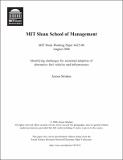Identifying Challenges for Sustained Adoption of Alternative Fuel Vehicles and Infrastructure
Author(s)
Struben, Jeroen J.R.,
Download4625-06.pdf (1.137Mb)
Metadata
Show full item recordAbstract
This paper develops a dynamic, behavioral model with an explicit spatial structure to explore the co-evolutionary dynamics between infrastructure supply and vehicle demand. Vehicles and fueling infrastructure are complementarities and their chicken-egg dynamics are fundamental to the emergence of a self-sustaining alternative fuel vehicle market, but they are not well understood. The paper explores in-depth the dynamics resulting from local demand-supply interactions with strategically locating fuel-station entrants. The dynamics of vehicle and fuel infrastructure are examined under heterogeneous socio-economic/demographic conditions. The research reveals the formation of urban adoption clusters as an important mechanism for early market formation. However, while locally speeding diffusion, these same micro-mechanisms can obstruct the emergence of a large, self-sustaining market. Other feedbacks that significantly influence dynamics, such as endogenous topping-off behavior, are discussed. This model can be applied to develop targeted entrance strategies for alternative fuels in transportation. The roles of other powerful positive feedbacks arising from scale and scope economies, R&D, learning by doing, driver experience, and word of mouth are discussed.
Date issued
2007-04-27Series/Report no.
MIT Sloan School of Management Working Paper4625-06
Keywords
diffusion, transitions, co-evolution, industry dynamics, transportation, fueling infrastructure, alternative fuels,, complementarities, spatial models, system dynamics